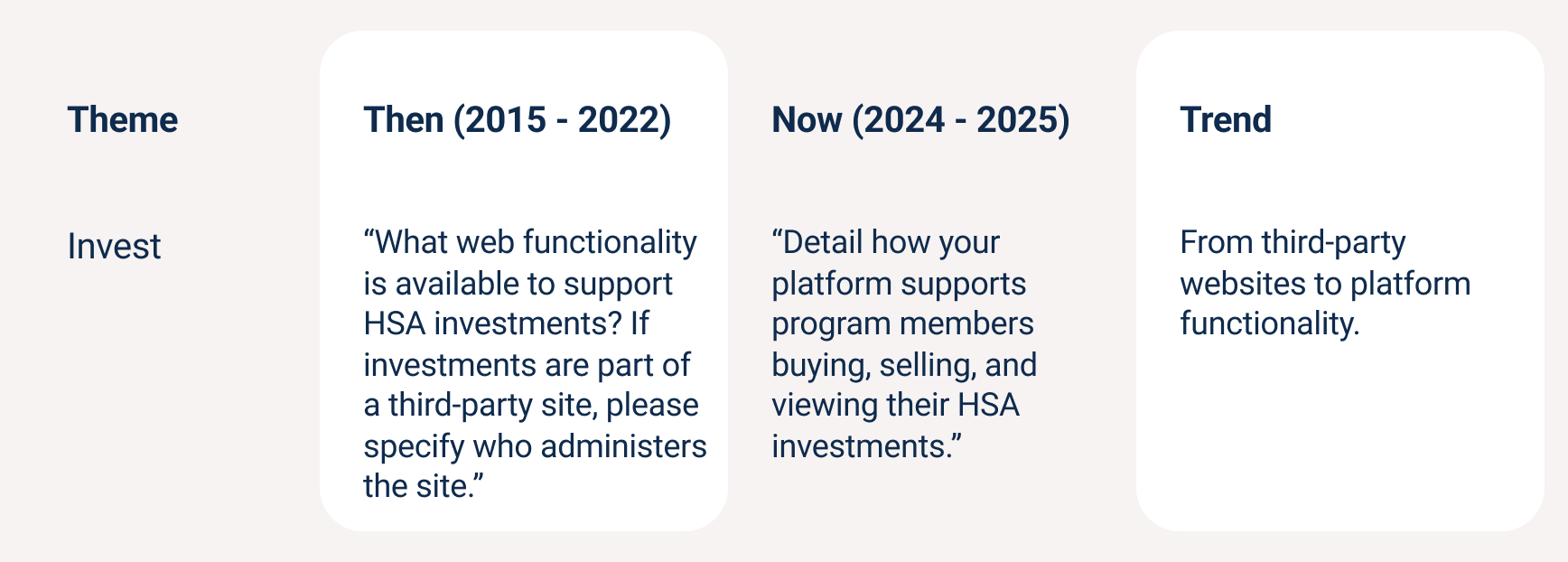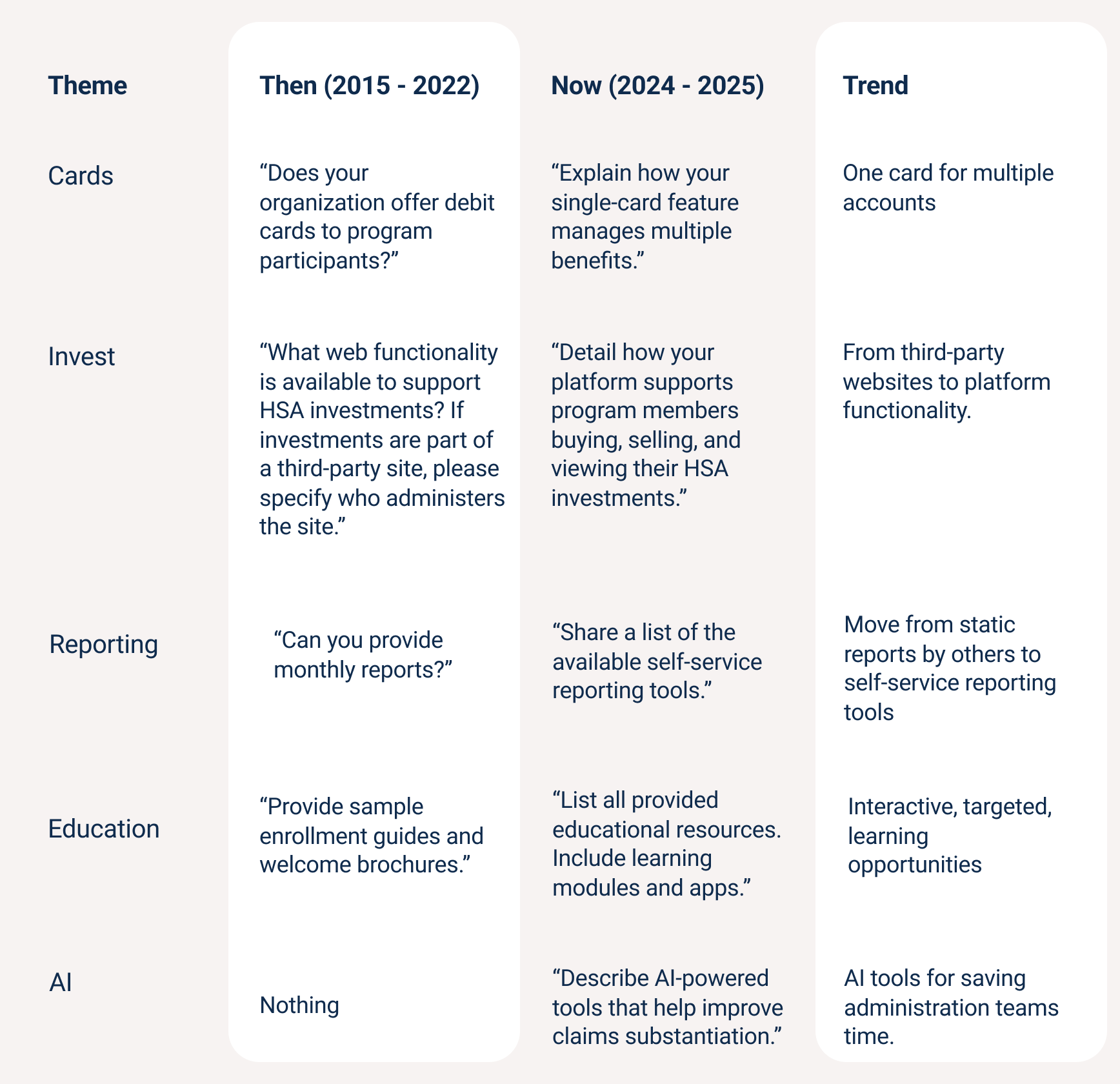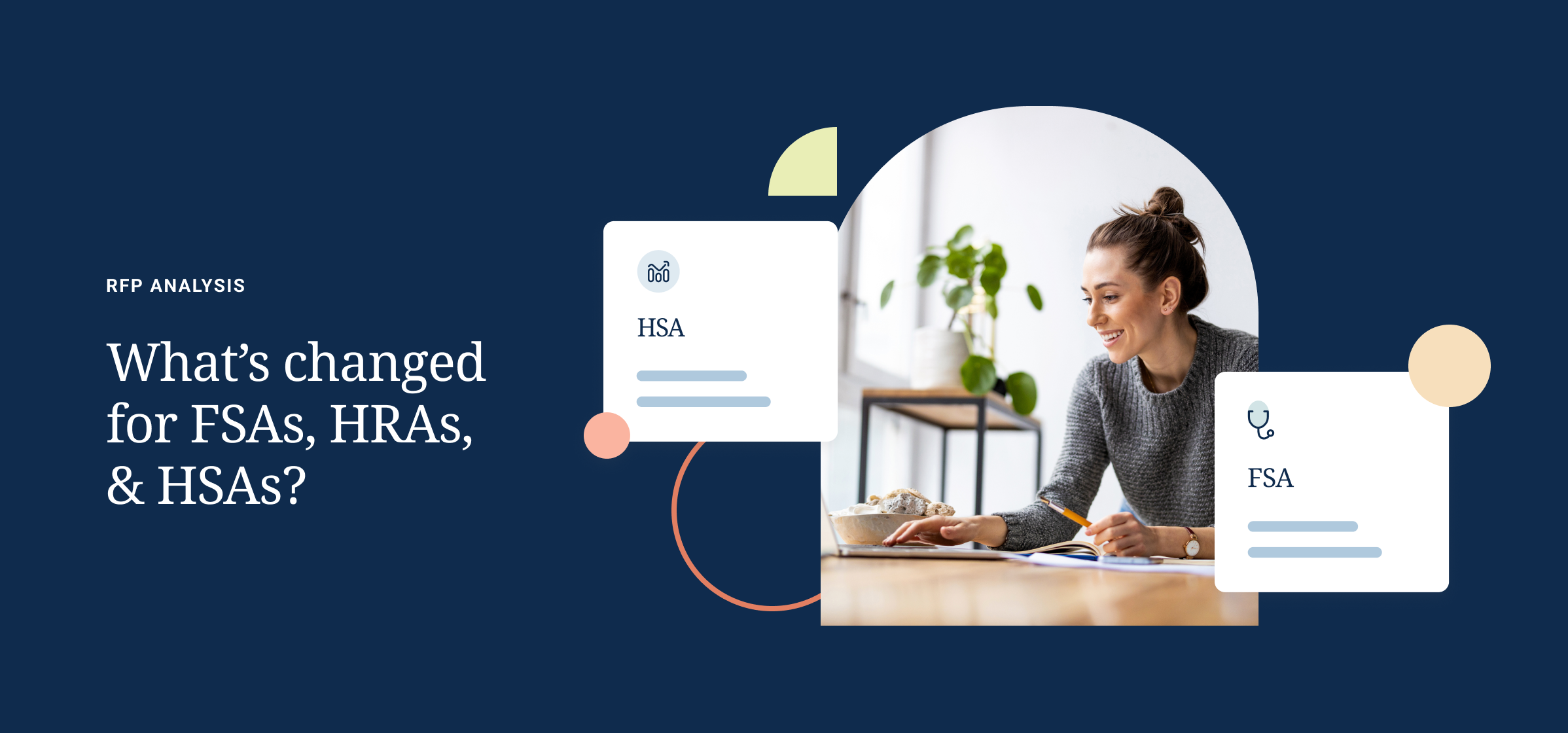When technology changes, so do our expectations. (Nobody asks for your AIM screen name* anymore.) And we see this evolution in expectations in request for proposal (RFP) questions; they don't ask 'em like they used to.
We wanted to know how RFP questions have changed, so we compiled a list, sorted them into two groups (current and past), and analyzed for trends. Our analysis revealed dramatic shifts: where RFPs once asked about monthly report delivery, they now demand drill-down analytics for dashboards. The evolution spans flexible spending accounts (FSAs), health reimbursement arrangements (HRAs), and health savings accounts (HSAs)—and it happened faster than you might expect.
*Hossball
Free template
Based on our analysis, we created a free resource with example questions you might see on an RFP. To diagnose your organization's readiness, download our 2025 RFP Template.
Method of research
Here’s how we conducted our research.
Sample size
We analyzed FSA, HRA, and HSA RFPs from two different periods: 2013-2021 and 2024-2025. While our sample set provides valuable directional insights, it’s not comprehensive enough to support definitive industry-wide conclusions. We treated these findings as conversation starters, validating them with industry subject matter experts who confirmed: “Yes, this aligns with what we’re seeing.” Our goal for the article is that it does the same for you and your team—helps you assess whether your current technology stack is ready for these emerging trends.
Card trends
For most participants, the arrival of a debit card in the mail marks the start of a new benefit. With proper card guardrails, cardholders can access their funds for eligible expenses with minimal administrative effort. Every substantiated card transaction is one less claim for admin review.
Then: Do you have a card?
Past questions focused on mere existence, such as, "Do you offer a debit card?" RFPs treated debit cards like a yes/no question, like something to check off a list. That's no longer the case.
Now: Do you have a card for everything?
In 2025, the focus has shifted from “Do you have a card?” to “Do you have a card that can manage multiple benefits?” And everyone’s searching for the right words to describe this type of card. In our research, we came across “debit card for both accounts,” “single card support,” and “multi-product payment cards.”
Virtual and international
We also noticed an increase in recent requests for virtual cards and the ability for cardholders to use their cards abroad.
Cards trend recap
.png)
About Virtual Cards
To learn about First Dollar’s virtual card product, check out our product release.
HSA investing trends
With an HSA, participants can make tax-free investments for tax-free growth. And since the average retired couple will need $351,000 for healthcare expenses, it’s no surprise that HSA investing was a popular topic in RFP requirements.
Then: What’s the name of the third-party website for HSA investing?
Past RFPs made two main assumptions: HSA investing would occur on a website, and another party would run that website. The RFPs just wanted to know who would be running that third-party website.
Now: What are your platform investing features?
Today's brokers want to know which HSA investment activities can occur on the platform; embedded HSA investing is the assumption. We also see higher expectations for the investment menu, with increased inquiries about fractional shares, automatic investing, and robo-advisor capabilities.
Investment recap

About embedded investing
To learn about First Dollar’s embedded investing for HSAs, available on our web portal and our app for participants, check out our product release.
Reporting trends
With good reporting tools, teams can quickly understand organization performance for service level agreement (SLA) target metrics, like know your customer (KYC) processing and claims adjudication.
Then: Who do we contact for new reports?
Now: What reporting can we do on our own?
Today, RFPs prioritize reporting tools over reporting support. We saw mentions of "interactive dashboards," "self-service capabilities," and "customizable visualizations." And we no longer see questions like "Can you provide monthly reports?" This new focus reflects a shift from vendor-controlled reporting with static reports to client-controlled reporting with self-service tools and interactive, customizable dashboards.
Industry Context
Employee usage of business intelligence and analytics is increasing. Data and analytics leaders attribute this to a rise in self-service authoring tools (73%) and embedded analytics (38%).
Reporting recap
.png)
About reporting
To learn about First Dollar’s reporting tools, check out our product release for our reporting API.
Education trends
Since day one, most industries have agreed that providing educational resources is important. And that's even more true today, as only 68% of plan participants report using all of their available benefits.
Then: What brochures will you provide?
Now: What learning opportunities will you provide to participants in their language?
The new RFP focus shifts from print materials to targeted, interactive learning experiences. For example, we saw requests for apps, calculators, and learning modules. We also came across requests for multi-language support.
Learning context
Interactive learning can increase student focus, engagement, and overall learning performance.
Education recap

AI trends
Everyone’s talking about AI, and the RFPs are as well. We’re excited to see how AI tools will continue to evolve to meet industry needs, like claims submission and consumer education.
Then: What’s AI?
As you likely expected, there were no RFP questions about AI tools before 2025.
Now: Name your AI-powered features.
Artificial intelligence is here, and RFPs are asking vendors to spell out their AI-driven features. We saw RFP queries about AI-driven tools for automated receipt scanning and claims adjudication. Soon, we anticipate seeing more questions for AI-driven tools for CDH pain points like fraud detection, customer support, predictive analytics, and more.
Market Context
According to McKinsey's 2025 State of AI report, 71% of respondents say their organizations regularly use generative AI.
AI future deep dive: Name your non-AI features
As the market adapts, AI will evolve from dominating conversation to dominating product. Reflecting this trend, RFPs will move from asking vendors for a list of AI-powered features to asking for features not powered by AI.
Tomorrow's winners will not only have AI-powered features but also the platform flexibility to evolve with new technology and regulation. When new capabilities emerge, the platform needs to adapt quickly, with no lengthy development cycles.
AI will automate the routine stuff—receipt scanning, basic claims processing, and simple questions. But benefits administration still needs human judgment for complex cases, strategic decisions, and relationships. We are in a business that ultimately services people, and we must keep that perspective amidst the adoption of AI.
The question will not be whether an organization has AI. It will be whether it balances AI efficiency with human expertise that counts.
AI recap

Trends recap
Here is a recap of the trends we noticed in the RFPs.

It’s about people
What’s behind these trends? At the end of the day, benefit RFPs reflect the needs of the people who use them.
Today’s consumer behavior
Over nine in ten U.S. adults own a smartphone, and they use it. Over eight in ten use a financial app, while one in two use a digital wallet. And let's not forget consumer adoption of AI. Chat GPT broke all consumer app records when it reached 100 million monthly active users (MAUs) within two months of launch.
Past focus on price
Past RFPs for consumer-directed health benefits like FSAs and HSAs focused on minimal noise and the lowest price. The technology was considered the same, as the same platform vendors power two/thirds of the marketplace, so the only way for organizations like third-party administrators (TPAs) to stand out in the bidding process was to have the lowest price.
Focus on tech
The trends reflect a growing need for benefits to catch up to consumer trends. Technology is no longer buried, and assumptions are no longer being made about what is possible. Bid applicants can stand out (and win) with better tech.
Next steps
To access more 2025 RFP questions, check out The New RFP: A FSA, HRA, & HSA Template for 2025.





.png)

